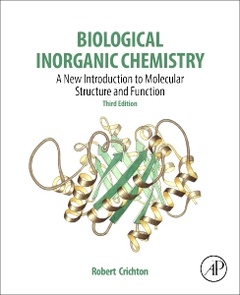Biological Inorganic Chemistry (3rd Ed.) A New Introduction to Molecular Structure and Function
Auteur : Crichton Robert R.

Biological Inorganic Chemistry: A New Introduction to Molecular Structure and Function, Third Edition, provides a comprehensive discussion of the biochemical aspects of metals in living systems. The fascinating world of the role of metals in biology, medicine and the environment has progressed significantly since the very successful Second Edition of the book published in 2012. Beginning with an overview of metals and selected nonmetals in biology, the book supports the interdisciplinary nature of this vibrant area of research by providing an introduction to basic coordination chemistry for biologists and structural and molecular biology for chemists.
Having built this accessible foundation, the book progresses to discuss biological ligands for metal ions, intermediary metabolism and bioenergetics, and methods to study metals in biological systems. The book also covers metal assimilation pathways; transport, storage, and homeostasis of metal ions; sodium and potassium channels and pumps; magnesium phosphate metabolism and photoreceptors; calcium and cellular signaling; the catalytic role of several classes of mononuclear zinc enzymes; the biological chemistry of iron; and copper chemistry and biochemistry.
In addition, the book discusses nickel and cobalt enzymes; manganese chemistry and biochemistry; molybdenum, tungsten, vanadium, and chromium; non-metals in biology; biomineralization; metals in the brain; metals and neurodegeneration; metals in medicine and metals as drugs; and metals in the environment. Now in its Third Edition, this popular and award-winning resource highlights recent exciting advances and provides a thorough introduction for both researchers approaching the field from a variety of backgrounds, as well as advanced students.
Part 1 Basic Principles 1. An overview of the role of metals in biology 2. Basic coordination chemistry for biologists 3. Structural and molecular biology for chemists 4. Biological ligands for metal ions 5. An overview of intermediary metabolism and bioenergetics 6. Methods which can be used to study metals in biology 7. Metal assimilation pathways 8. Transport, storage and homeostasis of metal ions
Part 2 Metals in Biology 9. Sodium and potassium – Channels and Pumps 10. Magnesium – phosphate metabolism and photoreception 11. Calcium – cellular signalling 12. Zinc – Lewis acid and gene regulator 13. Iron – essential for almost all life 14. Copper – Coping with Dioxygen 15. Nickel and Cobalt – evolutionary relics 16. Manganese –oxygen generation and detoxification 17. Molybdenum, Tungsten, Vanadium and Chromium 18. Non-metals in biology 19. Biomineralisation
Part 3 Metals in Medicine and the Environment 20. Metals in brain function 21. Metal-based Neurodegeneration 22. Metals in medicine and metals as drugs 23. Metals in the environment
Chemistry researchers and students.
The Second Edition of Biological Inorganic Chemistry: An Introduction to Molecular Structure and Function received the 2013 TEXTY Textbook Excellence Award in Physical Sciences from the Text and Academic Authors Association.
- Winner of a 2019 Textbook Excellence Award (Texty) from the Textbook and Academic Authors Association
- Includes a thorough survey of metals in biological systems: in the human body, in medicine and in the environment
- Previous winner (Second Edition) of the 2013 Textbook Excellence Award (Texty) from the Text and Academic Authors Association
- Features new sections: an overview of the different functions of essential metal ions; toxic metals in diagnosis and therapeutics; crystal and ligand field theory and their limitations; molecular orbital theory; genetic and molecular biological approaches to study metals; more complex cofactors and their biosynthesis; photosynthetic oxidation of water; man-made environmental pollution; and metals as poisons
Date de parution : 05-2018
Ouvrage de 692 p.
19x23.3 cm
Thèmes de Biological Inorganic Chemistry :
Mots-clés :
ATP; ATPase; Abiotic; Alcohol dehydrogenases; Aluminium; Alzheimer's disease; Amyotrophic lateral sclerosis; Anabolism; Assimilation; Astrocytes; B12-dependent isomerases; B12-dependent methyltransferases; Bio-geochemistry; Biochemistry; Biogeochemical cycles; Biological membranes; Biology; Biomineralization; Biotic; Brain; CRISPR-Cas9; Ca2+ chemistry; Ca2+-transporting proteins; Cadmium; Calcification; Calcium; Carbonic anhydrase; Catabolism; Cellular Ca2+; Channels; Chelate; Chlorophyll; Chromium; Cobalamine and cobalt proteins; Cocatalytic zinc enzymes; Coordination chemistry; Copper; Copper chemistry and biochemistry; Copper proteins; Copper-containing enzymes; Crystal field theory; DNA; Detoxification; EPR; Electron paramagnetic resonance; Electron transport; Electronic spectroscopy; Environmental pollution; Essential processes; Ferritin; Friedreich's ataxia; Gluconeogenesis; Haemoproteins; Halides; Haloacid dehalogenase; Heavy metals; Homeostasis; Huntington's disease; Hydrophobic effect; Iron; Iron chemistry; Iron-containing proteins; Lead; Ligand field; Ligands; Low-molecular weight substrates; Magnesium metabolism; Magnetic properties; Magnetosomes; Magnetotactic bacteria; Manganese; Mars and Venus; Mercury; Metabolism; Metal assimilation; Metal ion metabolism; Metal ions; Metal transport; Metal-based neurodegeneration; Metalloclusters; Metalloenzymes; Metalloproteinases; Metalloproteins; Metals; Methyl-CoM reductase; Microglia; Mn chemistry; Mn2+; Molybdenum; Mononuclear zinc enzymes; Mössbauer spectroscopy; NMR; Neuron; Nickel; Nickel enzymes; Nitrogenases; Noncorrin Co-containing enzymes; Nonmetals; Nonredox; Organic cofactors



